The world is moving towards greener boating, and electric outboard engines are leading the way. With over 10,000 reviews, they’re a hit in the marine electric propulsion field. They’re cleaner, quieter, and more efficient, making them great for those who want to help the planet.
Electric outboard engines are becoming more common as boating goes green. They’re a reliable and efficient choice for your boat, cutting down on carbon emissions. As tech gets better, we’ll see even more cool solutions for marine electric propulsion.
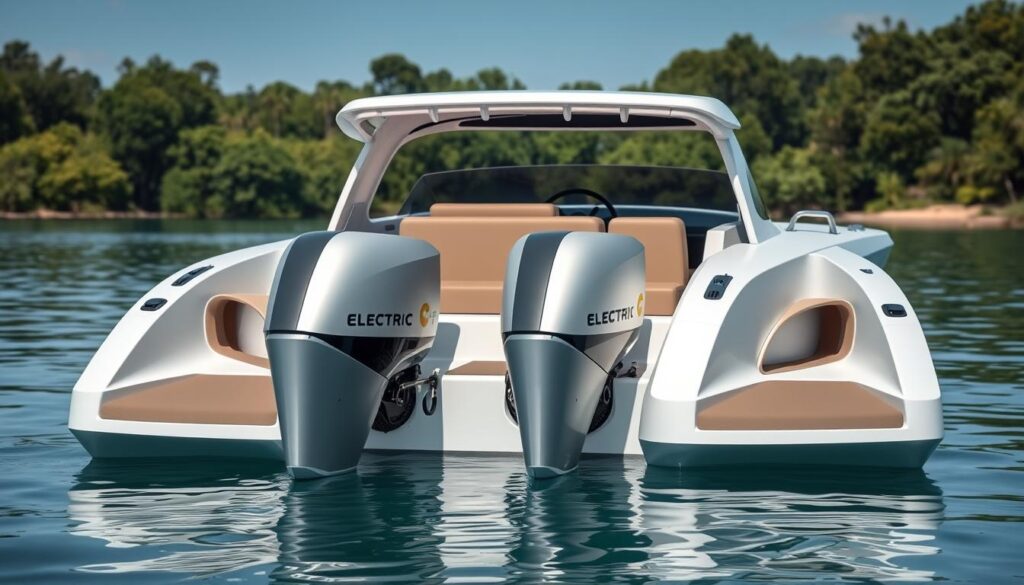
Key Takeaways
- Electric outboard engines are a sustainable alternative to traditional gas-powered engines
- They offer a quieter and more efficient way to power your boat
- With over 10,000 customer reviews, electric outboard engines are a popular choice among boaters
- They provide a reliable and efficient way to power your boat, while also reducing your carbon footprint
- Electric outboard engines are a viable option for dinghy propulsion and can be used on boats of various sizes
- They are designed to be environmentally friendly, with no emissions, odors, or sound during operation
Understanding Electric Outboard Engines for Boats
Electric outboard engines are a green alternative to gas-powered ones. They offer a quiet, efficient, and reliable ride. These engines are gaining popularity for their benefits, like less noise and lower upkeep.
They provide instant torque for efficient power. They also use less fuel than traditional motors, saving money. Plus, they don’t emit harmful emissions, appealing to eco-friendly boaters.
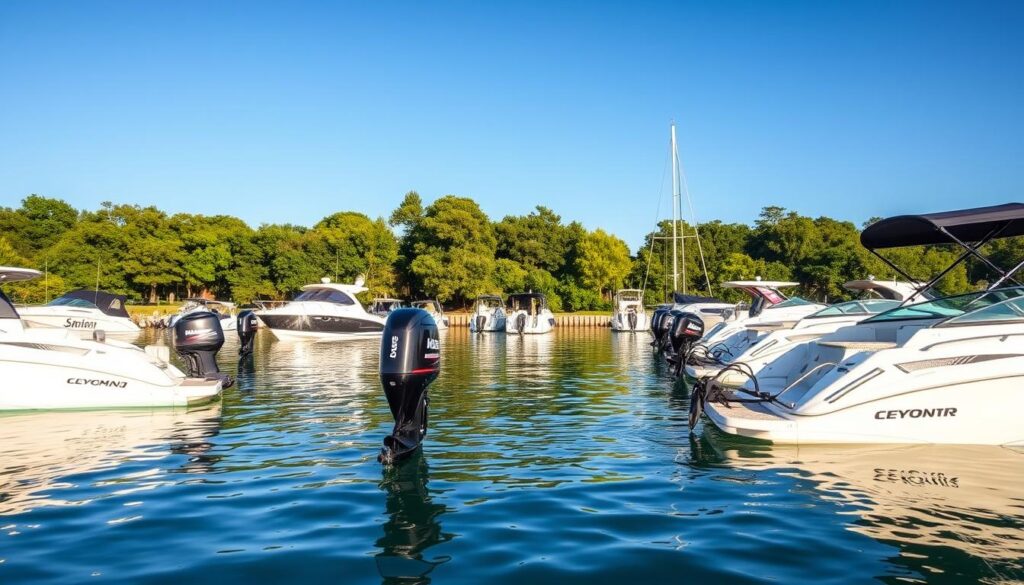
Electric outboard motors have high energy density thanks to lithium-ion batteries. Their brushless design means they last longer and have less friction. These features, along with being eco-friendly, make them a great choice for sustainable boating.
The motor, battery, and control system are key parts of electric outboard motors. The motor turns electrical energy into mechanical energy. The battery powers it, and the control system manages energy flow for safe and efficient use.
The Evolution of Marine Electric Propulsion
The history of marine electric propulsion started in 1838. Moritz Hermann von Jacobi’s electric boat made its first trip across the Neva River. It carried 14 passengers, marking the start of a long journey.
Over the years, we’ve seen big steps forward. The first commercial electric river launch, Electricity, was made in 1882. In 1905, the largest electric boat on the Thames, the 95-foot Victory, was launched.
Today, marine electric propulsion is getting more popular. This is thanks to better electric boat technology and a focus on the environment. As we look to the future, we’re seeing big improvements in electric boat performance and range.

Modern electric boats are impressive. The Tûranor PlanetSolar is the largest solar-powered boat in the world. The Frauscher Mirage also offers an electric drive option. As technology keeps getting better, we’ll see even more efficient marine electric propulsion systems.
| Year | Event | Description |
|---|---|---|
| 1838 | First electric boat trip | Moritz Hermann von Jacobi’s electric boat carries 14 passengers across the Neva River |
| 1882 | First commercial electric river launch | Electricity, a 7.6-meter long boat, is produced |
| 1905 | Largest electric boat on the Thames | The 95-foot Victory is launched |
Benefits of Electric Outboard Motors
Electric outboard motors have many advantages over traditional engines. They are good for the environment because they don’t release harmful emissions. This is key in places like Amsterdam, where they plan to ban old engines by 2025.
They also save money in the long run. Electricity is cheaper than diesel or gasoline in places like Norway. Plus, electric motors need less maintenance, saving up to 80% compared to old engines. For instance, Evoy’s electric motors have just four parts, unlike the 2,000 parts in most old engines.

- Reduced maintenance requirements due to fewer moving parts
- Cost savings over time through lower fuel and maintenance costs
- Environmental advantages, including zero emissions and reduced noise pollution
These perks make electric outboard motors a great choice for eco-friendly boating. As more people start boating, the need for these motors will grow. This will help make boating greener and reduce its impact on the environment.
Power and Performance Specifications
Electric outboard engine performance is key for boaters. Marine electric propulsion systems have improved a lot. They offer many benefits, like measuring power in kilowatts (kW) instead of horsepower (hp).
The Pure Watercraft electric outboard has a 25kW rating, like a 50hp internal combustion outboard. But, it’s actually about 33.5hp when you calculate it. Torqeedo’s 12kW electric outboard is said to be like a 25hp internal combustion outboard. Yet, it’s closer to 16hp when you do the math.

Electric motors, like those from Torqeedo, are very powerful. They can turn 44% to 56% of energy into propulsive power. This is way more than traditional engines. For example, the Torqeedo Travel motor can move a light boat over 10 nautical miles on just a little gas.
Electric outboard motors have many advantages:
- Zero harmful emissions
- Lower operating costs
- Higher efficiency and longer lifespan
- Advanced features like GPS sensors and smartphone connectivity
As people want more eco-friendly boating, electric outboard motors are getting popular. They offer great power and performance. Marine electric propulsion systems are changing the boating world.
Comparing Electric vs. Traditional Outboard Engines
Choosing the right outboard engine for your boat is key. You have to decide between electric and traditional outboards. Each has its own benefits and drawbacks, depending on your boat size, how you use it, and what you prefer. We’ll look at speed, range, fuel use, and how they affect the environment.
Boaters often think about speed and range. Traditional gas engines are powerful and go far, great for big boats and tough activities. Electric outboards, like the Mercury Avator series, are better for short trips in calm waters.
Speed and Range
Traditional engines are usually faster than electric ones. But, electric outboards are getting better, with some reaching 25 mph and going up to 50 miles on one charge.
Fuel Efficiency
Fuel use is important. Electric outboards use no fuel and don’t pollute, making them more efficient. They can cut greenhouse gas emissions by up to 90% compared to gas engines.
Environmental Impact
The impact on the environment matters a lot. Electric outboards don’t emit anything, making them better for the planet. They’re also quieter and vibrate less, perfect for fishing and other quiet activities.

In conclusion, choosing between electric and traditional outboards depends on your needs. Traditional engines are powerful and go far, but electric ones are better for the planet and save fuel. Think about speed, range, fuel use, and environmental impact to pick the best engine for you.
| Engine Type | Speed | Range | Fuel Efficiency | Environmental Impact |
|---|---|---|---|---|
| Electric Outboard | Up to 25 mph | Up to 50 miles | Zero Emissions | Environmentally Friendly |
| Traditional Outboard | Up to 50 mph | Up to 100 miles | Higher Emissions | Less Environmentally Friendly |
Installation Requirements and Considerations
Installing electric outboard engines requires careful planning. The power needed for the engine is a big factor. A good rule of thumb is to match the engine’s power with the battery’s capacity. This means each kilowatt of engine power needs a kilowatt-hour of battery capacity.
Adapting the boat’s design is also key. This might mean changing the transom or making special mounts for batteries and electronics. It’s also important to use materials that can handle the marine environment. This includes proper insulation and ventilation in battery areas to meet safety standards.
Some important things to think about for a successful install include:
- Ensuring the battery bank is compatible with the wiring, switches, and appliances
- Proper sizing of safety components like fuses and circuit breakers
- Matching the electrical current to the motor’s requirements
- Upgrading or adding charging systems, such as solar panels, to accommodate the new motor and battery bank needs
By carefully considering these factors and following proper installation procedures, boat owners can enjoy the benefits of installing electric outboard engines. These benefits include less maintenance, cost savings on fuel, and a greener boating experience.

It’s also vital to check local regulations and compliance standards for marine electrical systems. This ensures a safe and legal installation. With more people choosing electric outboard motors, proper installation and maintenance are more important than ever.
Battery Technology and Power Management
Electric outboard battery technology has made big strides. This has led to better power management systems. These systems help make electric outboard motors work better and go further.
Boat owners can now use their batteries longer and save money. This is thanks to smart energy use and charging.
Electric outboard battery tech includes cool features like advanced charging and battery types made for the sea. For instance, lithium-ion batteries are popular because they pack a lot of energy and last a long time. Power management systems also work with other parts to make electric outboards efficient.
To get the most range, electric outboard motors have special features. These include:
- Advanced battery management systems
- Efficient propulsion systems
- Energy recovery systems
These features help use less energy and go further. This makes electric outboard motors great for fun boating and other sea uses.

Thanks to electric outboard battery tech and power management, boating is now more green and affordable. As more people want electric outboard motors, makers are working hard to make them better, cheaper, and more efficient.
| Battery Type | Energy Density | Lifespan |
|---|---|---|
| Lithium-ion | 200 Wh/kg | 3000 cycles |
| Lead-acid | 50 Wh/kg | 500 cycles |
Cost Analysis and ROI
When looking at the cost of electric outboard engines, it’s key to think about long-term gains and return on investment. The starting price of electric outboard engines is higher than traditional ones, costing between $X and $Y. Yet, running them costs much less, with electricity often being up to seven times cheaper than diesel or gas.
The battery system is a big part of the cost of electric outboard engines. It’s expected to get cheaper, from $B per kWh in 2022 to $C per kWh by 2044. This drop in battery cost will help make electric outboard engines more affordable. They could save boat owners a lot of money, with fuel savings leading to ROI gains of X% for different types of boats.

- Lower maintenance needs due to fewer moving parts
- Reduced operating expenses and enhanced profitability over time
- Environmental benefits, including a reduction in CO2 emissions
As more people want electric outboard engines, thanks to government help and green rules, their prices will likely fall. This makes them a better choice for boat owners. With big return on investment and long-term savings, electric outboard engines are a promising new trend in the marine world.
Leading Manufacturers and Models
Several key players lead the electric outboard engine market. Companies like ePropulsion, Elco, Flux Marine, and Pure Watercraft are at the forefront. They bring innovation and high performance to electric boating. This makes electric boats more affordable for many people.
Popular models include the ePropulsion Spirit 1.0 EVO and the Torqeedo 1103. The ePropulsion Spirit 1.0 EVO can reach 6.0mph and has a thrust of 31kg. The Torqeedo 1103 goes up to 4.4mph and has a thrust of 68lbs. Prices range from around $2,000 for the ePropulsion Spirit 1.0 EVO to $1,500 for the Torqeedo 1103.
Here is a comparison of some popular electric outboard models and their prices:
| Model | Top Speed | Thrust | Price |
|---|---|---|---|
| ePropulsion Spirit 1.0 EVO | 6.0mph | 31kg | $2,000 |
| Torqeedo 1103 | 4.4mph | 68lbs | $1,500 |
| Haswing Ultima 3 | 4.0mph | 51lbs | $1,200 |

These manufacturers and models provide a variety of options for electric boating. They cater to different needs and budgets, with various performance levels.
Maintenance and Care Guidelines
Proper care and maintenance are key to keeping electric outboard engines running well. Regular checks and cleanings of battery terminals are vital. Neglect can slow down how well electricity flows.
It’s also important to keep an eye on battery levels. Letting the battery drain completely can shorten its life a lot.
Some important tips for maintaining electric outboard engines include rinsing the motor with fresh water after each use. This helps prevent corrosion, which is more common in saltwater areas. Storing the motor correctly during winter is also critical. Keep it clean and dry to extend its life.
Using smart chargers and trickle chargers can also help keep the battery healthy. This prevents overcharging.
Regular maintenance offers many benefits:
- It keeps the value of your investment high.
- It reduces the chance of performance problems.
- It makes enjoying time on the water trouble-free.
- Maintenance is simpler and cheaper than fixing issues.
By following these tips and staying on top of maintenance, your electric outboard engine will run smoothly for years. Tools like the Siren Connected Boat app can help track maintenance schedules and history. This makes it easier to keep up with care and maintenance.
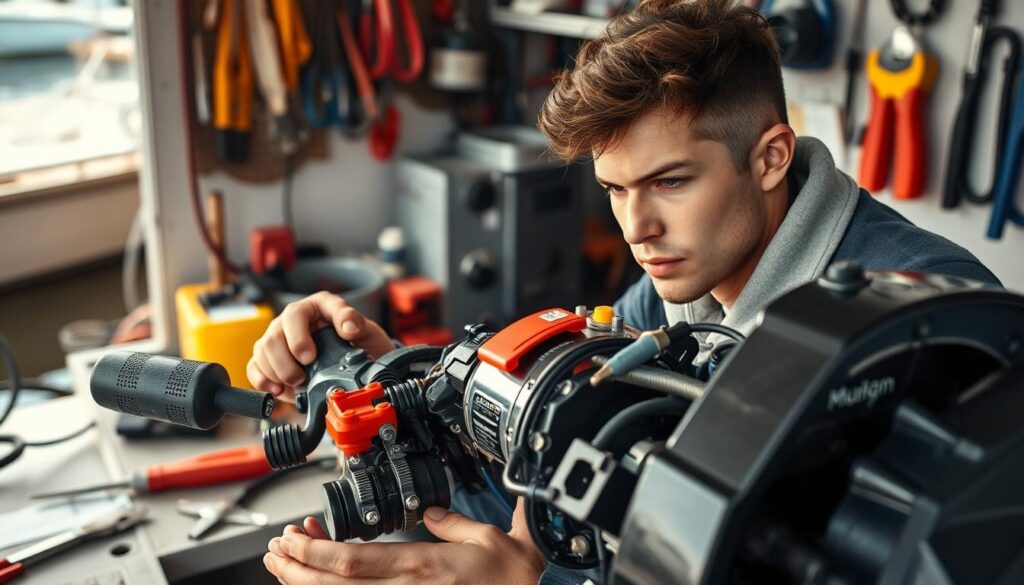
Safety Features and Regulations
Safety is key when it comes to electric outboard motors. They have features to protect users from dangers like electrical shock or accidents with the propeller. It’s also important for them to follow strict safety rules.
Electric outboards come with safety systems like automatic shut-off and propeller guards. These help prevent accidents and make boating safer. They also meet rules from the US Coast Guard and the International Maritime Organization.
Manufacturers must follow strict safety standards to be compliant. This includes rules for electrical systems, propulsion, and steering. Following these standards helps prevent accidents and ensures a safe boating experience. The safety features and rules are vital for protecting users and preventing accidents.
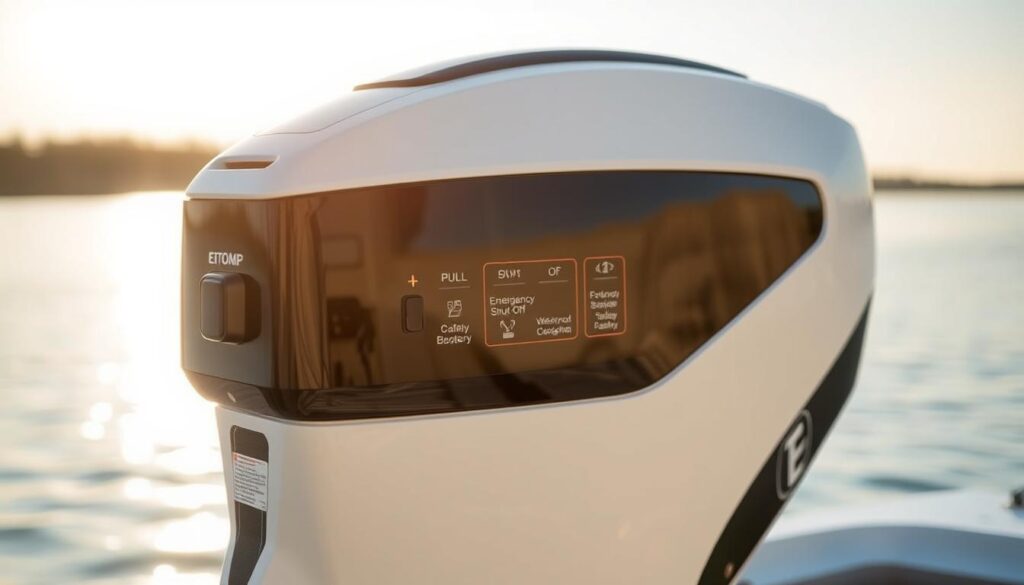
Electric outboards have many benefits. They are quieter, need less maintenance, and are more reliable. They also don’t produce any exhaust emissions, making them better for the environment. Choosing an electric outboard means a safer and greener boating experience.
Choosing the Right Electric Outboard
Choosing the right electric outboard engine is key for a great boating experience. The size of your boat matters a lot. A bigger boat needs a more powerful engine to move fast and go far.
Think about how you’ll use your boat too. For fishing or slow cruising, a trolling motor is quiet and easy to steer. But for water sports or fast cruising, you’ll need a stronger engine.
Don’t forget about the cost. Consider the engine’s price, maintenance, and charging costs. Also, check local boating laws to avoid fines and legal trouble.
Popular electric outboards include the TRAVEL 1103 CS, CRUISE 2.0 RL, and CRUISE 2.0 FP Pod Drive. The TRAVEL 1103 CS goes about 40 nautical miles slow, while the CRUISE 2.0 RL can hit 7 knots fast.

- Boat size and weight
- Usage pattern and intended activities
- Budget and ongoing expenses
- Local boating laws and regulations
| Model | Range at Slow Speed | Range at Full Throttle |
|---|---|---|
| TRAVEL 1103 CS | 40.0 nautical miles | 4.6 nautical miles |
| CRUISE 2.0 RL | 27.0 nautical miles | 8.0 nautical miles |
| CRUISE 2.0 FP Pod Drive | 24.3 nautical miles | 10.5 nautical miles |
Real User Experiences and Reviews
Looking at electric outboard engine reviews and user experiences is key when buying an electric outboard engine. Many users have seen a big drop in environmental harm. They love not having to deal with fuel smells or spills.
For example, one user has used the Torqeedo 603 electric outboard for two years. They use it on their boat, Equinox, which is only on land for a month each year.
Some users have made changes to make their outboards better. They’ve added safety features like an M6 A4 stainless steel threaded eye bolt. They’ve also made the shaft handle easier to use.
But, some users wish for better design. They want dust or ingress covers for the electrical connectors. One user used a carbonated water bottle cap to protect the connectors.

Other electric outboards, like the ePropulsion Spirit 1.0, can go up to 4 knots fast. They last 1.5 hours on a battery. Users love how quiet they are and how they help the environment.
One user said talking while boating is now softer because of the quiet outboard.
The ePropulsion Spirit 1.0 EVO has regenerative charging. It gets 40W at 4 knots and 300W at 10 knots. The Torqeedo 603 and others perform well, just like traditional engines. By reading electric outboard engine reviews and user experiences, buyers can make smart choices.
Environmental Impact and Sustainability
Electric outboard engines are great for the environment. They cut down greenhouse gas emissions by up to 80% compared to gas engines. This makes boating much cleaner.
Some key benefits of electric outboards include:
- Reduced noise pollution, with noise levels decreased by 50% or more
- Lower operating costs, with up to 90% savings in fuel costs over time
- Increased efficiency, with electric outboard motors reaching up to 90% efficiency compared to 20-30% for conventional combustion engines
The demand for eco-friendly boating is rising fast. Electric outboard motors are seeing over 20% growth each year as of 2023. With the right care, these batteries can last 2,500 to 5,000 charging cycles.
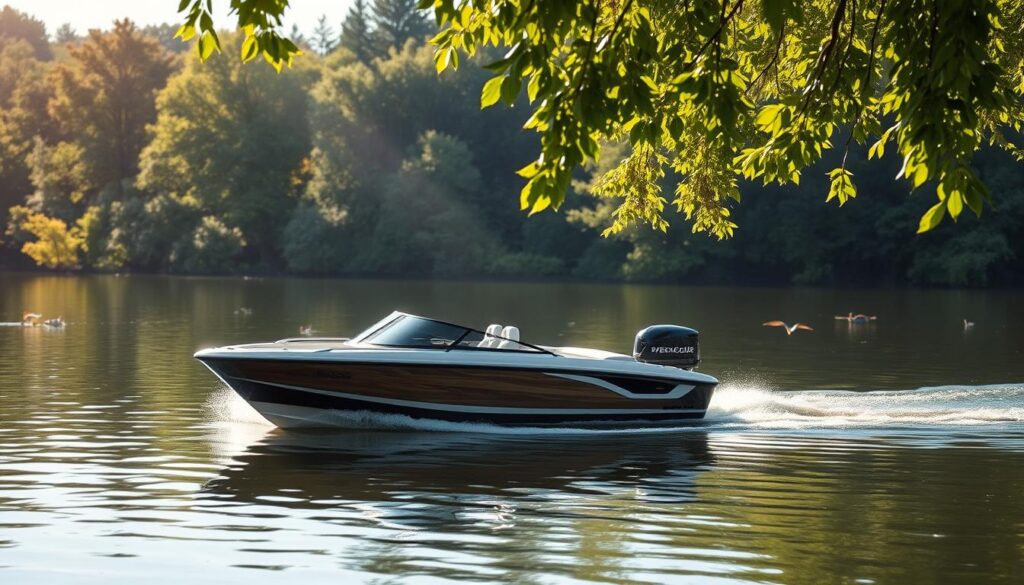
Electric outboards are a top choice for those wanting to be kinder to the planet. They offer a great way to enjoy the water while reducing harm to the environment.
| Electric Outboard Motor Benefits | Description |
|---|---|
| Reduced Greenhouse Gas Emissions | Up to 80% reduction compared to traditional gasoline engines |
| Lower Noise Pollution | Noise levels decreased by 50% or more |
| Increased Efficiency | Up to 90% efficiency compared to 20-30% for conventional combustion engines |
Future Developments in Electric Marine Technology
The future of electric outboard engines looks bright. Ongoing marine technology advancements aim to boost performance, efficiency, and eco-friendliness. With stricter emission rules, electric outboards are set to become more popular, sparking innovation and investment.
New battery tech is a big deal. It means electric outboards can go further and faster. This makes them a strong contender against traditional gas engines.
More charging spots are popping up at marinas and harbors. This makes it easier for boat owners to keep their electric outboards charged. It’s a big plus for electric outboards.
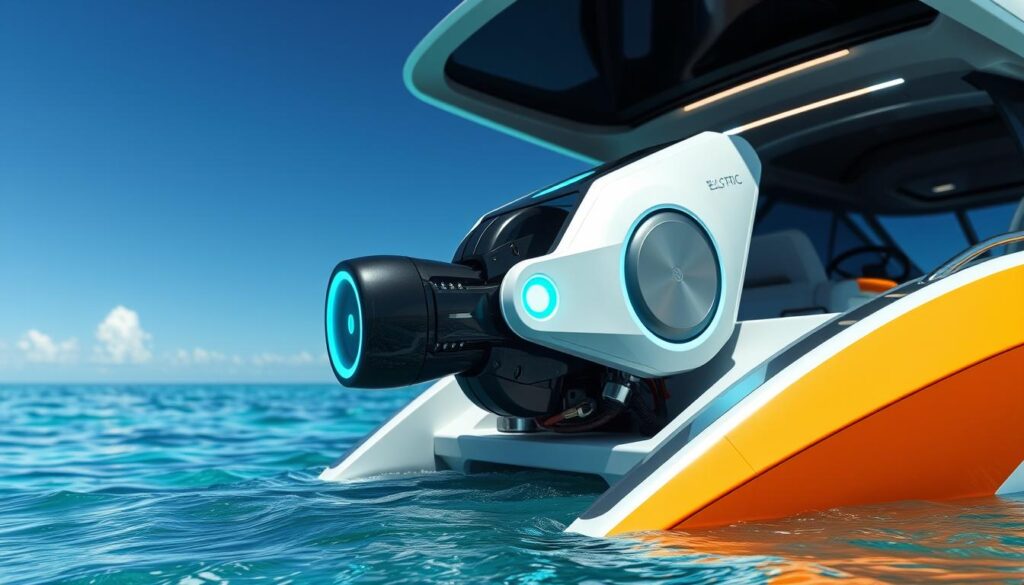
As the field grows, we’ll see even more marine technology advancements. Expect more efficient and powerful electric motors. This will make electric outboards appealing to more people, from hobbyists to professionals.
| Technology | Current Status | Future Developments |
|---|---|---|
| Battery Technology | Advancements in energy density and charging times | Increased range and faster charging times |
| Electric Motors | More efficient and powerful motors | Wider adoption and increased performance |
| Charging Infrastructure | Expansion of charging stations | Increased convenience and adoption |
In summary, the future of electric outboard engines is exciting. Ongoing marine technology advancements are driving progress. As the industry keeps growing, we’ll see more improvements. This will make electric outboards a great choice for boat owners everywhere.
Common Troubleshooting Tips
When dealing with troubleshooting electric outboard engines, several common issues arise. Regular maintenance and quick action to unusual motor behavior can greatly extend their life. A dead or low battery is a common problem. It can be avoided by regularly checking the battery’s charge and ensuring connections are secure and free from corrosion.
Other frequent problems include reduced speed, which might point to issues with the propeller or electrical system. Also, unusual noises like grinding or squealing could be due to lack of lubrication or debris in the motor. To tackle these issues, start with simple checks and move to more detailed diagnoses if needed.
Some common troubleshooting steps include:
- Checking the propeller for debris or damage
- Inspecting electrical connections for corrosion or wear
- Ensuring proper lubrication of greasing points
- Verifying the battery’s charge level and condition
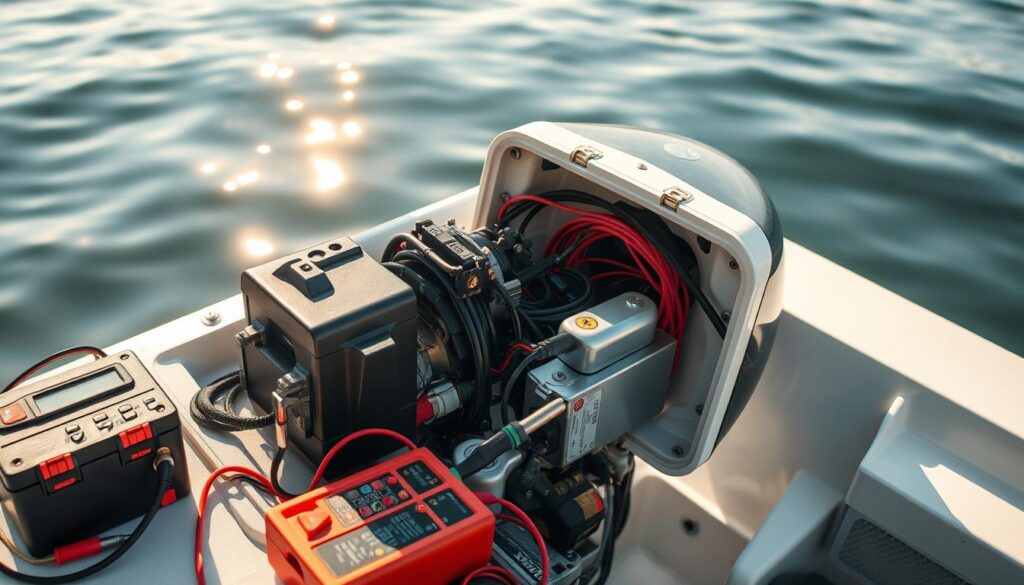
By following these tips and keeping up with regular maintenance, you can avoid common problems. This ensures your electric outboard engine operates smoothly and efficiently. Always refer to your owner’s manual or seek professional help if you’re unsure about any troubleshooting or maintenance steps.
| Common Issue | Troubleshooting Step |
|---|---|
| Dead or low battery | Check battery charge level and connections |
| Reduced speed | Inspect propeller and electrical system |
| Unusual noises | Check lubrication and look for debris in the motor |
Conclusion
Electric outboard engines for boats are becoming a great choice over traditional gas motors. They use new battery tech and motor designs. This makes them more eco-friendly and cost-effective for boaters.
The cost of getting an electric outboard engine is high at first. But, you save money on fuel, need less maintenance, and help the environment. These benefits make electric outboards more appealing.
The electric boat market is growing fast. We’ll see even better electric outboard engines soon. Companies like ACEL and Vision Marine are leading the way.
If you love boating or want to try electric outboards, now is the perfect time. This technology is exciting and full of possibilities.
FAQ
What are electric outboard engines?
Electric outboard engines are a new way to power boats. They use electric motors instead of old-fashioned engines. They’re getting popular because they’re good for the environment and keep getting better.
How do electric outboard engines work?
These engines run on rechargeable batteries and an electric motor. The motor pushes the boat forward. You can charge the batteries with a plug or with solar or wind power.
What are the key components of an electric outboard engine?
The main parts are the electric motor, batteries, a controller, and the propeller. You also need wiring, mounts, and sometimes extra stuff like coolers or screens.
What are the environmental advantages of electric outboard engines?
They don’t make any direct pollution, are quieter, and can run on clean energy. This makes boating better for the planet.
How do the power and performance of electric outboard engines compare to traditional engines?
Electric engines are getting stronger and better. They might not go as fast or as far as gas engines. But they’re quieter, have more power right away, and use less energy.
What are the installation requirements for electric outboard engines?
Putting in an electric engine needs careful planning. You have to mount the motor, set up the batteries, and wire everything right. It depends on your boat and engine.
What types of batteries are used in electric outboard engines?
They usually use lithium-ion or lead-acid batteries. The type affects how long they last, how fast they charge, and how far they can go.
How do the costs of electric outboard engines compare to traditional engines?
Electric engines cost more to buy. But they save money over time because they’re cheaper to run and maintain. This can make them a smart choice in the long run.
What are some of the leading manufacturers of electric outboard engines?
Top makers include BRP (Evinrude), Elco Motor Yachts, Torqeedo, and Yamaha. They offer many models to fit different needs and budgets.
What safety features are included in electric outboard engines?
They have safety features like overload protection and cooling systems. They also follow safety rules to keep you safe while boating.
How do I choose the right electric outboard engine for my boat?
Think about your boat’s size, weight, and how you’ll use it. Also, consider your budget and what you want from the engine. Look at range, speed, and power to find the best one.
What are some common troubleshooting tips for electric outboard engines?
Troubleshooting often means checking the batteries or looking into performance issues. Regular maintenance is key to keeping your engine running well.